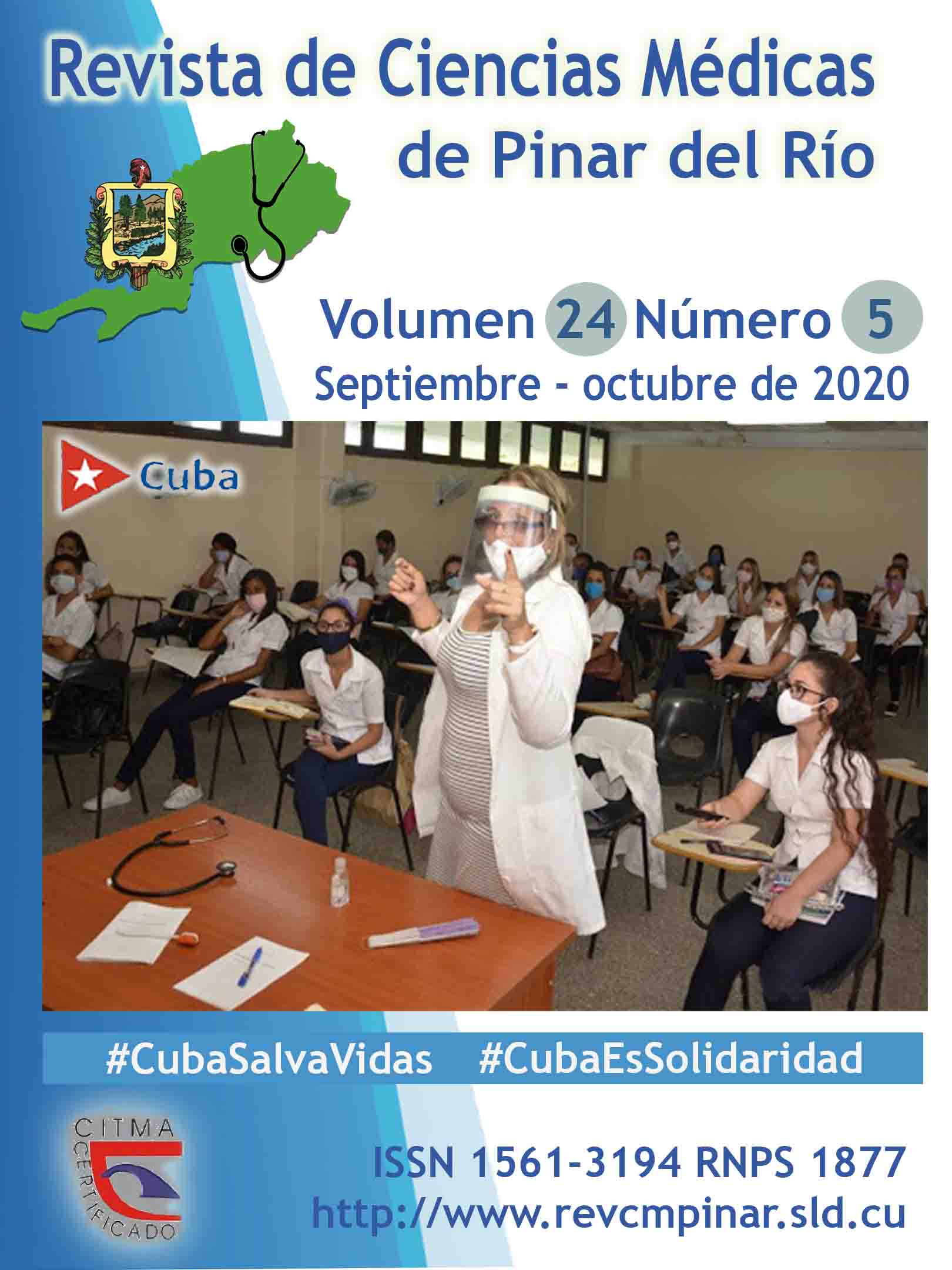Management of acute bronchiolitis in the pediatric pulmonology service in Pinar del Río
Keywords:
BRONCHIOLITIS/ETIOLOGY, HOSPITALS, PEDIATRIC, PULMONARY MEDICINE, CHILDAbstract
Introduction: acute bronchiolitis is the most frequent lower respiratory tract infection in children under one year of old and accounts for 18% of all pediatric hospitalizations.
Objective: to characterize the management of acute bronchiolitis in patients admitted to the pulmonology service at Pepe Portilla Pediatric Teaching Hospital during 2019.
Methods: an observational, descriptive and cross-sectional study was carried out. The target group comprised 612 patients diagnosed with bronchiolitis and the sample included 482 patients who met the inclusion criteria: moderate, mild cases with risk factors and clinical history with complete data. Descriptive statistical techniques were applied to process the information collected.
Results: patients were admitted for mild bronchiolitis (75.9%), with an average stay of less than 5 days. Complete Blood Count (CBC), erythrocyte sedimentation and chest radiography was performed in 100% of patients, with low percentage of positivity. Prechordal ultrasound was reported in 15.6% by transitory auscultation of cardiac murmurs. Oxygen therapy was prescribed in 98.9% of cases, with no clinical evidence of hypoxemia.
Conclusions: there was an excess in the indication of complementary examinations and medication prescription. There was found an irrational prescription of inhaled bronchodilators, systemic steroids and antihistamines. There is dependence on diagnostic means, which reflects the need for a better application of the clinical method.
Downloads
References
1.- García García ML, Korta Murua J, Callejón Callejón A. Bronquiolitis aguda viral. Pediatr [Internet]. 2017 [citado 20/02/2020]; 1: 85-102. Disponible en: https://www.aeped.es/sites/default/files/documentos/06_bronquiolitis_aguda_viral_0.pdf
2.- Ochoa Sangrador C. Manejo de la bronquiolitis aguda en atención primaria: análisis de variabilidad e idoneidad. An Pediatr (Barc) [Internet]. 2013 [citado 20 /02/2020]; 79(3): 167-176. Disponible en: https://www.analesdepediatria.org/es-pdf-S1695403313000556
3.- García F, De la Cruz R. Actualización en la etiopatogenia de la bronquiolitis aguda. 16 de Abril [Internet]. 2018 [citado 3/03/2020]; 57(268):125-134. Disponible en: https://www.medigraphic.com/pdfs/abril/abr-2018/abr18268j.pdf
4.- Fuentes C, Cornejo G, Bustos R. Actualización en el tratamiento de bronquiolitis aguda: menos es más. Neumol Pediatr [Internet] 2016 [citado 20/02/2020]; 11(2): 65-70. Disponible en: http://www.neumologia-pediatrica.cl/wp-content/uploads/2017/07/tratamiento-broncoquiolitis.pdf
5.- Claudio Castaños C, Susana Rodríguez M. (Coor. GAP 2013: Manejo de la Bronquiolitis [Internet]. Argentina: Hospital de Pediatría uan P. Garrahan; 2015. [citado 20/02/2020]. Disponible en: http://www.laboratoriosmar.com.ar/interno/trabajos_cientificos/63_Manejo-de-la-Bronquiolitis-actualizacion-2019.pdf
6. Arredondo Escalante JC, Cabezas Canoles H. Caracterización de la severidad de la bronquiolitis en menores de dos años en el Hospital Niño Jesús de Barranquilla durante los años 2015 y 2016. Revista Biociencias [Internet]. 2018 [citado 3/03/2020]; 13(1): 31-35. Disponible en: https://revistas.unilibre.edu.co/index.php/biociencias/article/view/2141
7.- Bahena Parra MT. Tratamiento de bronquiolitis aguda viral en pacientes menores de 2 años en el hospital de bosa durante el año 2014. Revista Neuronum [Internet]. 2019 [citado 20/02/2020]; 5(2). Disponible en: http://eduneuro.com/revista/index.php/revistaneuronum/article/view/193
8.- Ruiz Silva MD, Hernández Pérez I, Montes de Oca Domínguez M. Comportamiento clínico-epidemiológico de la bronquiolitis aguda en lactantes admitidos. Belmopán, Belice. 2015. Multimed [Internet]. 2017 [citado 20/02/2020]; 21(3): 174-189. Disponible en: https://www.medigraphic.com/pdfs/multimed/mul-2017/mul173c.pdf
9.- Pinchak C, Schelotto M, Borges P, Zunino V, Cuturi B, Izuibejeres C, et al. Modificaciones en el tratamiento de pacientes con bronquiolitis luego de la radiografía de tórax. Archivos de Pediatría del Uruguay [Internet]. 2017 [citado 20/02/2019]; 88(4): 189-19. Disponible en: www.scielo.edu.uy/scielo.php?pid=S1688-12492017000400189&script=sci_arttext&tlng=pt
10.- Benito Fernández J, Paniagua Calzón N. Diagnóstico y tratamiento de la bronquiolitis aguda en urgencias. En: protocolos diagnósticos y terapéuticos en urgencias de pediatría. Sociedad Española de Urgencias de Pediatría (SEUP) [Internet]. 3a. ed. España; 2019 Oct [citado 20/02/2020]. Disponible en: https://seup.org/pdf_public/pub/protocolos/5_Bronquio.pdf
11.- Arraut Collazos PB, Lesmes Agudelo AC. Caracterización de la población con bronquiolitis en la clínica Infantil colsubsidio en el año 2013 [Tesis]. Argentina: Universidad del Rosario; 2015 [citado 20/02/2020]. Disponible en: https://repository.urosario.edu.co/handle/10336/10515?show=full
Downloads
Published
How to Cite
Issue
Section
License
Authors who have publications with this journal agree to the following terms: Authors will retain their copyrights and grant the journal the right of first publication of their work, which will be publication of their work, which will be simultaneously subject to the Creative Commons Attribution License (CC-BY-NC 4.0) that allows third parties to share the work as long as its author and first publication in this journal are indicated.
Authors may adopt other non-exclusive license agreements for distribution of the published version of the work (e.g.: deposit it in an institutional telematic archive or publish it in a volume). Likewise, and according to the recommendations of the Medical Sciences Editorial (ECIMED), authors must declare in each article their contribution according to the CRediT taxonomy (contributor roles). This taxonomy includes 14 roles, which can be used to represent the tasks typically performed by contributors in scientific academic production. It should be consulted in monograph) whenever initial publication in this journal is indicated. Authors are allowed and encouraged to disseminate their work through the Internet (e.g., in institutional telematic archives or on their web page) before and during the submission process, which may produce interesting exchanges and increase citations of the published work. (See The effect of open access). https://casrai.org/credit/



